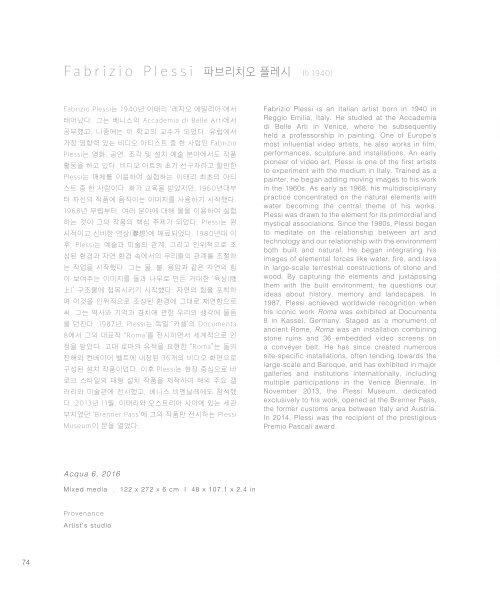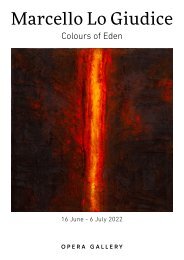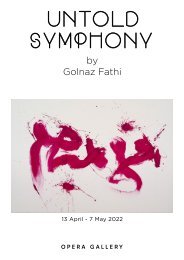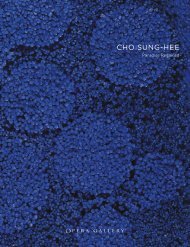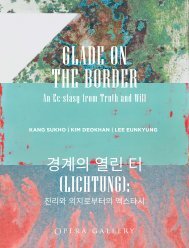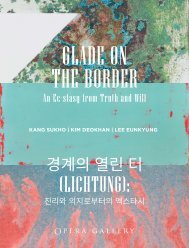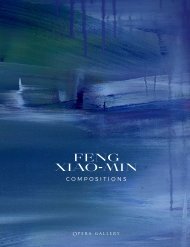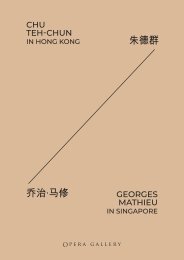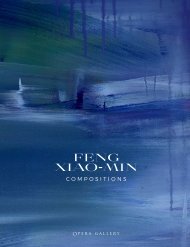Seoul Re-Opening
Catalogue for the Seoul Re-Opening Exhibition
Catalogue for the Seoul Re-Opening Exhibition
You also want an ePaper? Increase the reach of your titles
YUMPU automatically turns print PDFs into web optimized ePapers that Google loves.
Fabrizio Plessi 파브리치오 플레시<br />
(b.1940)<br />
Fabrizio Plessi는 1940년 이태리 ‘레지오 에밀리아’에서<br />
태어났다. 그는 베니스의 Accademia di Belle Arti에서<br />
공부했고, 나중에는 이 학교의 교수가 되었다. 유럽에서<br />
가장 영향력 있는 비디오 아티스트 중 한 사람인 Fabrizio<br />
Plessi는 영화, 공연, 조각 및 설치 예술 분야에서도 작품<br />
활동을 하고 있다. 비디오 아트의 초기 선구자라고 할만한<br />
Plessi는 매체를 이용하여 실험하는 이태리 최초의 아티<br />
스트 중 한 사람이다. 화가 교육을 받았지만, 1960년대부<br />
터 자신의 작품에 움직이는 이미지를 사용하기 시작했다.<br />
1968년 무렵부터, 여러 분야에 대해 물을 이용하여 실험<br />
하는 것이 그의 작품의 핵심 주제가 되었다. Plessi는 원<br />
시적이고 신비한 연상( 聯 想 )에 매료되었다. 1980년대 이<br />
후, Plessi는 예술과 미술의 관계, 그리고 인위적으로 조<br />
성된 환경과 자연 환경 속에서의 우리들의 관계를 조절하<br />
는 작업을 시작했다. 그는 물, 불, 용암과 같은 자연의 힘<br />
이 보여주는 이미지를 돌과 나무로 만든 거대한 ‘육상( 陸<br />
上 )’ 구조물에 접목시키기 시작했다. 자연의 힘을 포착하<br />
여 이것을 인위적으로 조성된 환경에 그대로 재연함으로<br />
써, 그는 역사와 기억과 경치에 관한 우리의 생각에 물음<br />
을 던진다. 1987년, Plessi는 독일 ‘카셀’의 Documenta<br />
8에서 그의 대표작 “Roma’를 전시하면서 세계적으로 인<br />
정을 받았다. 고대 로마의 유적을 표현한 “Roma”는 돌의<br />
잔해와 컨베이어 벨트에 내장된 36개의 비디오 화면으로<br />
구성된 설치 작품이었다. 이후 Plessi는 현장 중심으로 바<br />
로크 스타일의 대형 설치 작품을 제작하여 해외 주요 갤<br />
러리와 미술관에 전시했고, 베니스 비엔날레에도 참석했<br />
다. 2013년 11월, 이태리와 오스트리아 사이에 있는 세관<br />
부지였던 ‘Brenner Pass’에 그의 작품만 전시하는 Plessi<br />
Museum이 문을 열었다.<br />
Fabrizio Plessi is an Italian artist born in 1940 in<br />
<strong>Re</strong>ggio Emilia, Italy. He studied at the Accademia<br />
di Belle Arti in Venice, where he subsequently<br />
held a professorship in painting. One of Europe’s<br />
most influential video artists, he also works in film,<br />
performances, sculpture and installations. An early<br />
pioneer of video art, Plessi is one of the first artists<br />
to experiment with the medium in Italy. Trained as a<br />
painter, he began adding moving images to his work<br />
in the 1960s. As early as 1968, his multidisciplinary<br />
practice concentrated on the natural elements with<br />
water becoming the central theme of his works.<br />
Plessi was drawn to the element for its primordial and<br />
mystical associations. Since the 1980s, Plessi began<br />
to meditate on the relationship between art and<br />
technology and our relationship with the environment<br />
both built and natural. He began integrating his<br />
images of elemental forces like water, fire, and lava<br />
in large-scale terrestrial constructions of stone and<br />
wood. By capturing the elements and juxtaposing<br />
them with the built environment, he questions our<br />
ideas about history, memory and landscapes. In<br />
1987, Plessi achieved worldwide recognition when<br />
his iconic work Roma was exhibited at Documenta<br />
8 in Kassel, Germany. Staged as a monument of<br />
ancient Rome, Roma was an installation combining<br />
stone ruins and 36 embedded video screens on<br />
a conveyer belt. He has since created numerous<br />
site-specific installations, often tending towards the<br />
large-scale and Baroque, and has exhibited in major<br />
galleries and institutions internationally, including<br />
multiple participations in the Venice Biennale. In<br />
November 2013, the Plessi Museum, dedicated<br />
exclusively to his work, opened at the Brenner Pass,<br />
the former customs area between Italy and Austria.<br />
In 2014, Plessi was the recipient of the prestigious<br />
Premio Pascali award.<br />
Acqua 6, 2016<br />
Mixed media . 122 x 272 x 6 cm I 48 x 107.1 x 2.4 in<br />
Provenance<br />
Artist’s studio<br />
74


